Workforce transitions are inevitable. Whether it’s a planned retirement, a sudden resignation, or an unexpected organizational shift, the question is not if leadership gaps will arise—but when. In these moments, having proactive succession planning strategies in place can mean the difference between seamless continuity and organizational disruption.
Unfortunately, many businesses—especially small to mid-sized firms—delay HR transition planning until it’s too late. That’s where Interim HR Consulting becomes a critical asset. Interim HR professionals bring fresh, objective expertise to help organizations identify key roles, nurture internal talent, implement structured mentorship, and continuously optimize their leadership development pipeline.
In this guide, we explore how interim HR support enhances succession planning strategies—from risk assessment to talent development and long-term continuity.
Identifying Key Roles and Succession Gaps
Effective succession planning strategies begin with clarity: which roles are mission-critical, and what vulnerabilities exist if those roles suddenly go unfilled?
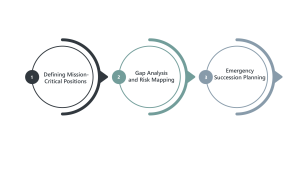
1. Defining Mission-Critical Positions
Key roles extend beyond C-suite titles. They include any position where the loss of institutional knowledge, client relationships, or decision-making authority would significantly impact business operations. Interim HR consultants help you audit and define these roles based on organizational structure, strategic goals—especially in industries like healthcare consulting firms and hospital staffing services, where talent gaps can be critical.
2. Gap Analysis and Risk Mapping
An interim HR expert conducts a succession risk assessment, identifying where the organization is most vulnerable. This includes:
- Employees nearing retirement
- Individuals with unique, non-documented knowledge
- Roles with no immediate internal successors
- High-turnover or burnout-prone positions
Using tools like 9-box grids, and organizational charts, interim HR support identifies vulnerabilities in your current structure. This is particularly vital in sectors facing healthcare staffing challenges, such as medical staffing solutions and emergency healthcare staffing.
3. Emergency Succession Planning
Beyond long-term gaps, interim HR professionals assist in building emergency succession protocols. This ensures that unexpected departures don’t paralyze the business and that interim leaders or deputies are identified in advance.
Developing Talent Pipelines
Once critical roles are defined, the next step in succession planning strategies is building and maintaining a strong leadership development pipeline.
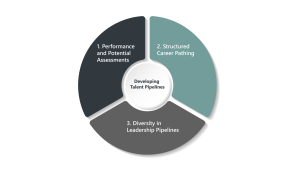
1. Performance and Potential Assessments
Interim HR consultants leverage frameworks like the Performance vs. Potential Matrix to identify high-potential (HiPo) employees. They use 360-degree reviews, engagement scores, and manager evaluations to determine who is ready for advancement—and who needs further development.
2. Structured Career Pathing
With interim support, organizations can map out transparent and motivating career paths that align with succession goals. This includes identifying:
- Key competencies for future roles
- Learning and development milestones
- Lateral opportunities that prepare employees for vertical growth
Clear career progression pathways reduce attrition, build morale, and ensure that internal talent is ready when leadership roles open up.
3. Diversity in Leadership Pipelines
Succession planning must be inclusive. Interim HR consultants help businesses audit and correct disparities in their leadership pipelines, ensuring equal access to advancement opportunities across gender, ethnicity, and age groups. This not only improves culture but also strengthens innovation and adaptability.
Mentorship and Knowledge Transfer Strategies
An often overlooked but critical piece of succession planning strategies is knowledge transfer.
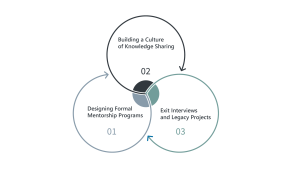
1. Designing Formal Mentorship Programs
Interim HR experts design and implement structured mentorship systems that match senior leaders with high-potential employees. These programs may include:
- Goal-setting and milestones
- Regular check-ins
- Reverse mentoring elements (e.g., digital fluency training from younger employees)
Mentorship creates space for trust-building, contextual learning, and cultural transfer—all of which are difficult to capture in documentation alone.
2. Building a Culture of Knowledge Sharing
In fast-paced companies, knowledge can easily become siloed. Interim HR professionals introduce knowledge management systems (like shared digital playbooks or SOP databases) that make organizational wisdom accessible to future leaders.
They also foster collaborative environments where sharing insights is embedded into day-to-day work—through practices like job shadowing, cross-functional projects, and leadership roundtables.
3. Exit Interviews and Legacy Projects
When a planned departure is on the horizon, interim consultants guide organizations in executing knowledge transfer initiatives. This includes comprehensive exit interviews, training handovers, and “legacy documentation” where outgoing leaders record key learnings, contact lists, and project histories.
Monitoring and Adjusting Succession Plans
Succession planning strategies is not a one-and-done task—it’s a living strategy that must evolve with business priorities, talent trends, and organizational change.
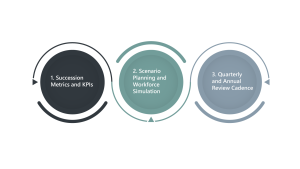
1. Succession Metrics and KPIs
With interim HR support, companies can implement dashboards and key performance indicators to monitor:
- Readiness coverage for each key role
- Progress of talent development programs
- Success rates of internal promotions
- Turnover in leadership pipeline roles
This data-driven approach ensures accountability and continuous optimization.
2. Scenario Planning and Workforce Simulation
Interim HR professionals use scenario planning tools to model the impact of workforce changes—like retirements, restructures, or expansions—on succession readiness. This allows leadership teams to make proactive adjustments rather than reactive moves.
For example, if a business is expanding into a new market, interim consultants can assess whether current talent pipelines support that growth—or if external recruitment must supplement succession efforts.
3. Quarterly and Annual Review Cadence
Regular reviews ensure succession planning strategies remain aligned with overall goals and market shifts, supporting long-term operational excellence consulting.
Why Interim HR Support Enhances Succession Strategy
Many companies delay succession planning strategies because internal HR teams are stretched thin. Here’s how Interim HR Consulting bridges that gap effectively:
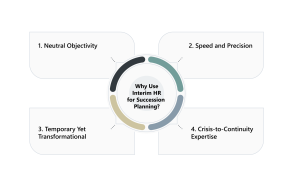
- Neutral Objectivity: As external experts, interim consultants bring unbiased assessments of leadership readiness and potential—unclouded by office politics or legacy bias.
- Speed and Precision: They quickly implement processes and frameworks, drawing from best practices used across industries.
- Temporary Yet Transformational: Interim HR consultants often act as architects—designing and launching systems that internal teams can manage long after the engagement ends.
- Crisis-to-Continuity Expertise: Whether dealing with emergency transitions or long-range planning, interim HR professionals are equipped to guide organizations through uncertainty with confidence.
Final Thoughts
Succession planning strategies aren’t just about preparing for retirement—it’s about building continuity, resilience, and growth capacity across every layer of your business.
By identifying internal vulnerabilities, building a reliable leadership development pipeline, and implementing structured mentorship and review systems, companies can stay prepared—especially those navigating healthcare staffing challenges or seeking executive placement firms to complement internal succession efforts.
Prepare Your Organization for Tomorrow—Starting Today
Whether you’re a growing healthcare firm, a company facing internal restructuring, or just aiming to optimize leadership capacity—Interim HR Consulting is your partner in success.
Explore how succession planning strategies powered by interim HR support can strengthen your organization today.
Explore our services and schedule a strategic consultation today.
